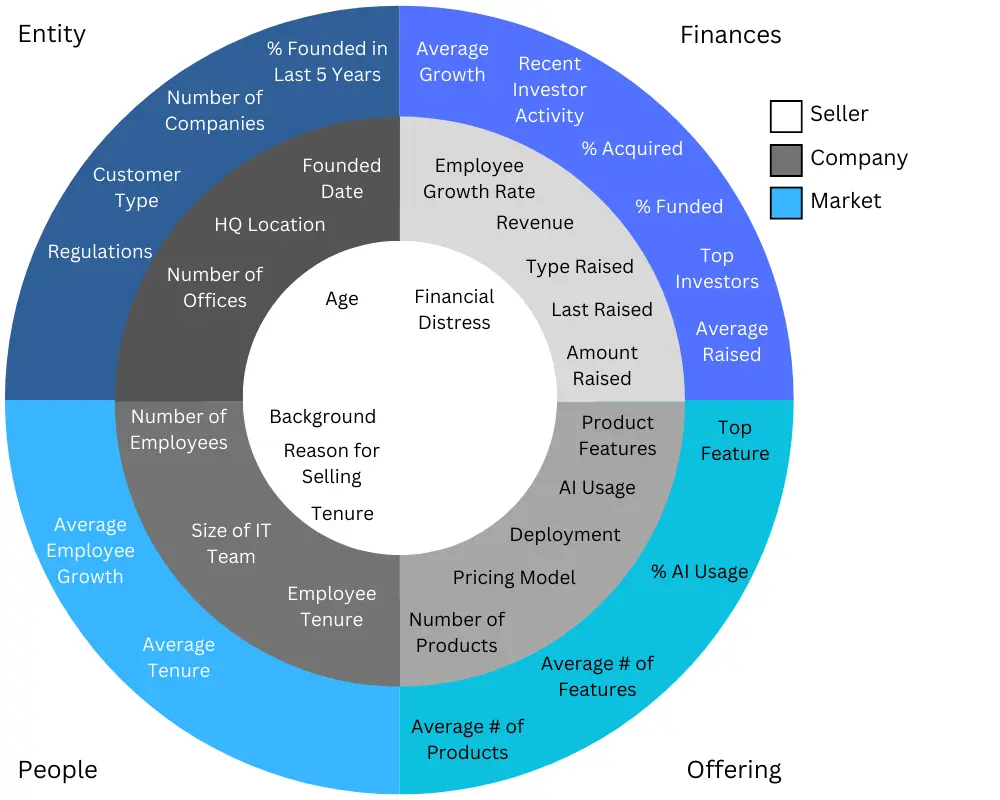Building a Data-Driven Investment Strategy Framework
Research has shown that a programmatic approach to M&A has consistently generated above-average returns. A data-driven investment strategy helps you prioritize your time, make better decisions, and ultimately create outlier long-term value.
Our systematic framework ensures consistency and scalability across your entire investment process while capturing institutional knowledge for future deals.

Everyone has their own idea of what constitutes an investment strategy. While every industry has its own characteristics, and every investor has their own beliefs or preferences, we still believe there can be a standard approach to building a framework for investment strategy.
Our approach relies on a system of spheres, slices, and parameters where each sphere represents a broader category of parameters and each slice permeates multiple spheres.
Framework Assumptions
For the sake of simplicity, we'll assume that:
We are building a framework for software companies
The seller is the same as the CEO - i.e. the company is not owned by a PE fund so most decisions to sell the company are made by the CEO
The Three Spheres Framework
A systematic approach to categorizing and analyzing investment opportunities through interconnected data layers
Seller (Inner Sphere)
The seller is the inner sphere of our framework - understanding the motivations and background of decision makers.
Personal Factors:
Age
Background
Tenure
Financial Distress
Motivations:
Reason for Selling
Company (Middle Sphere)
The company sphere covers operational, financial, and product-related data points.
Entity:
Founded Date
HQ Location
Number of Offices
People:
Number of Employees
Size of IT Team
Employee Tenure
Offering:
Number of Products
Pricing Model
Deployment
Product Features
AI Usage
Finances:
Revenue
Employee Growth Rate
Last Raised
Amount Raised
Type Raised
Market (Outer Sphere)
The market sphere provides aggregated insights across all companies in the same industry.
Entity Metrics:
Number of Companies
% Founded in Last 5 Years
Customer Type
Regulations
People Metrics:
Average Employee Growth
Average Tenure
Offering Metrics:
Average # of Products
Average # of Features
Top Feature
% AI Usage
Finance Metrics:
% Acquired
% Funded
Top Investors
Average Raised
Recent Investor Activity
Average Growth
Interconnected Framework
Each sphere provides context for the others, creating a comprehensive view of investment opportunities. Data flows between spheres to inform decision-making at every level.

Getting the Data
A successful investment strategy framework requires robust data infrastructure to collect, process, and analyze information across all three spheres.
Seller Data
Networking websites (LinkedIn, industry directories)
Team interactions and relationship building
CRM integration for relationship tracking
Company Data
Website scraping and Generative AI extraction
Financial databases and SEC filings
Product demos and technical analysis
Market Data
Aggregated company data analysis
Industry reports and market research
Competitive intelligence platforms
Data Infrastructure Requirements
Implementing this framework successfully requires a centralized data warehouse that can integrate information from multiple sources and provide real-time insights across all three spheres. This infrastructure should support:
Technical Capabilities
Real-time data ingestion from multiple sources
Automated data cleaning and standardization
Generative AI for unstructured data extraction
Advanced analytics and pattern recognition
Secure data sharing across team members
Business Benefits
Consistent evaluation criteria across all deals
Institutional knowledge preservation
Faster due diligence processes
Better pattern recognition and trend analysis
Improved investment committee presentations
Framework Implementation
Our Investment Strategy services ensure you have all the relevant data and systems to empower your decision making across every stage of the investment process.
Traditional Approach
Ad-hoc data collection for each deal
Inconsistent evaluation criteria
Manual research and analysis
Knowledge lost between deals
Difficulty comparing opportunities
Verus Ventures Framework
Systematic data collection across all spheres
Standardized evaluation parameters
Automated data processing and analysis
Institutional knowledge preservation
Consistent cross-deal comparisons
The Verus Advantage
Faster Due Diligence
Better Pattern Recognition
Consistent Evaluation
Custom framework design tailored to your investment thesis
Integrated data infrastructure supporting all three spheres
Ongoing refinement based on deal outcomes and market changes
Training and support for your investment team
Seamless integration with existing deal sourcing and portfolio management systems